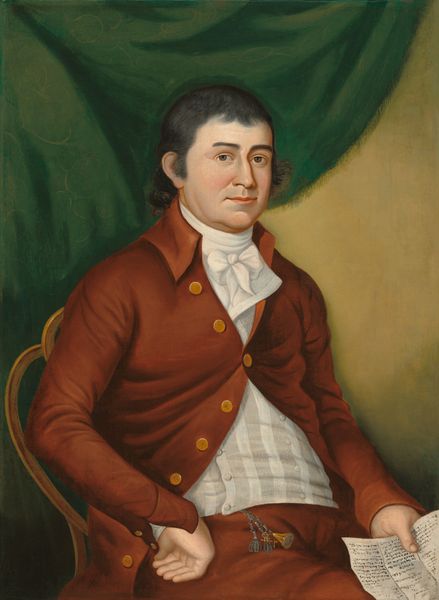
painting, oil-paint, oil-on-canvas
#
portrait
#
portrait
#
painting
#
oil-paint
#
figuration
#
romanticism
#
history-painting
#
oil-on-canvas
Dimensions: 29 3/8 x 24 1/2 in. (74.61 x 62.23 cm) (canvas)
Copyright: Public Domain
Editor: This is "Portrait of Moses Kimball" painted around 1808 by William Jennys. It’s an oil on canvas. What immediately strikes me is the directness of his gaze; he’s looking right at us. What do you make of it? Curator: The direct gaze is certainly compelling. Beyond that, I am drawn to the formal attire – the cravat, the dark coat with its rows of buttons. What might these signify about Kimball’s identity or aspirations in the early 19th century? Consider what visual echoes resonate today with symbols of power. Editor: Well, it definitely speaks to a certain social status, a respectable figure. It feels very intentional, almost like he's trying to project an image. Curator: Precisely! The question then becomes: what image? Note the way the artist captures the sitter’s particular, slightly asymmetrical features. Does that undermine, or reinforce, the projection you identified? Think about the symbolism embedded in portraiture itself, a lasting legacy. Editor: I see what you mean. It's both idealized and quite human at the same time. So it's not just about status but also about individual character? Curator: Indeed. Perhaps this juxtaposition, of status and individualized elements, tells us something more profound about early American identity during this time of societal shift. What symbols and projections are we crafting today in our own portraiture? Editor: That's a fascinating way to look at it; I hadn't considered the connection to contemporary portraiture and its purpose. Curator: Looking at historical symbolism, you see cultural memory reflected in seemingly simple compositions like this portrait, which is a continuity, if we reflect on it consciously.
Comments
minneapolisinstituteofart almost 2 years ago
⋮
Moses Kimball, a dry-goods merchant in Newburyport, Massachusetts, was a typical sitter for William Jennys, an itinerant portrait painter who traveled around New England depicting members of the merchant class. Jennys, born in Boston, trained with his father, also a portraitist. His style is characterized by a realistic rendering and heavy shading of the sitter's face. Conservation of this painting was made possible by a generous contribution through the Art Champions program in honor of Sam and Patty McCullough.
Join the conversation
Join millions of artists and users on Artera today and experience the ultimate creative platform.













